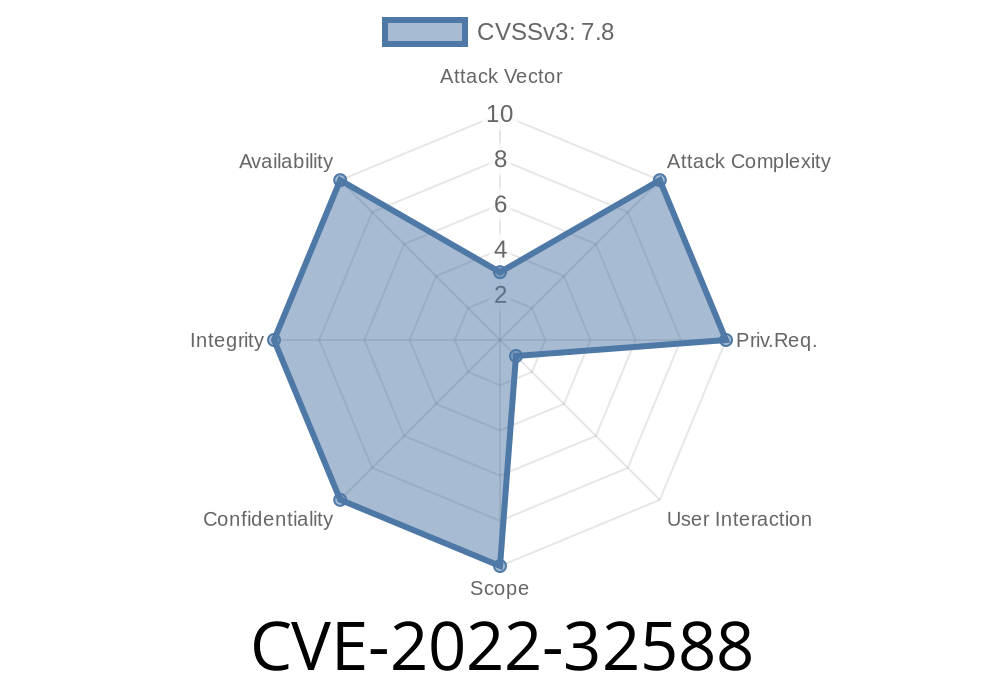In this long-read post, we will delve into CVE-2022-32588, an out-of-bounds write vulnerability discovered in Accusoft ImageGear 20.'s PICT parsing functionality (pctwread_14841). We'll provide an overview of the vulnerability and break down its code structure. Additionally, we'll explore how to exploit this vulnerability by providing a malicious file, and touch upon potential consequences and mitigation techniques.
Original references
- NVD: CVE-2022-32588
- Accusoft ImageGear 20.
Vulnerability Details
CVE-2022-32588 is an out-of-bounds write vulnerability that exists in the PICT parsing functionality of Accusoft ImageGear 20., specifically the pctwread_14841 function. An attacker can exploit this vulnerability by supplying a specially crafted malformed file, which leads to memory corruption. Although the severity and potential impact of this vulnerability have not been officially scored or rated, memory corruption can often lead to denial of service (DoS), data leakage, or remote code execution (RCE), depending on the extent of the corruption.
Code Structure of pctwread_14841
The pctwread_14841 function is responsible for parsing and processing PICT image files, an older and less-common file format for storing images. The following code snippet demonstrates how the pctwread_14841 function processes a PICT input file:
...
int pctwread_14841(pctw_param_t* param) {
uint32_t opcode, dataSize;
...
while (1) {
dataSize = read_uint32();
if (dataSize < 2 || dataSize > INT_MAX) {
return PCTWREAD_ERROR_INVALID_FILE;
}
opcode = read_uint16();
switch (opcode) {
case PICT_OPCODE_1:
...
break;
case PICT_OPCODE_2:
...
break;
...
}
}
}
...
This is a simplified example of the pctwread_14841 function, which reads the PICT file's input data in chunks (dataSize), processes the data according to specific opcodes, and continues reading and processing data until it reaches the end of the input file.
Exploiting the Vulnerability
To exploit this vulnerability, an attacker must provide a malicious PICT file that triggers the out-of-bounds write. We can use the Python Imaging Library (PIL) to create a malformed PICT file containing the necessary opcode and carefully crafted dataSize values that result in memory corruption. Here's some sample Python code to generate such a file:
from PIL import Image
img = Image.new('RGB', (256, 256), color='white')
img.save('malicious_file.pict', 'PICT')
with open('malicious_file.pict', 'r+b') as f:
f.seek(x50)
f.write(b'\xFF\xFF\xFF\xFF') # dataSize causing memory corruption
f.write(b'\xAB\xCD') # Malicious opcode
This code snippet generates a new image file titled 'malicious_file.pict' with the RGB color space, a white background, and a size of 256x256 pixels. The script then inserts an opcode and a dataSize value to corrupt memory. We must carefully determine dataSize to manipulate the execution flow of the pctwread_14841 function, potentially resulting in unintended behavior or crashes.
Possible Consequences and Mitigation
Memory corruption vulnerabilities, such as CVE-2022-32588, can lead to several negative consequences, including denial-of-service, data leakage, and, in some cases, remote code execution. However, the specific outcome depends on factors like the extent of memory corruption, the state of the executing environment, and the attacker's meticulous crafting of the malformed file.
To mitigate this vulnerability, it's essential to keep your software up-to-date and monitor the Accusoft ImageGear's release notes for any security patches or updates related to this vulnerability. Furthermore, developers can implement input validation and proper bounds-checking mechanisms when processing PICT files, ensuring that potential out-of-bounds writes are detected and handled appropriately.
Conclusion
In this post, we've explored the details surrounding CVE-2022-32588, which affects the pctwread_14841 function within Accusoft ImageGear 20.. We dove into how an attacker could exploit this vulnerability by providing a malicious file and the possible consequences of successful exploitation. While memory corruption vulnerabilities can be dangerous, being aware of potential risks and maintaining updated software can significantly reduce their impact.
Timeline
Published on: 11/09/2022 18:15:00 UTC
Last modified on: 11/10/2022 06:46:00 UTC
